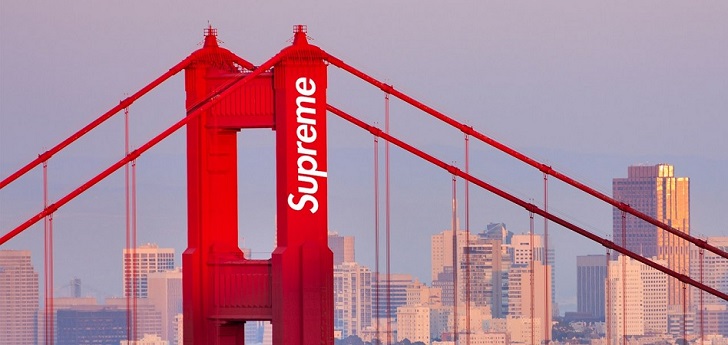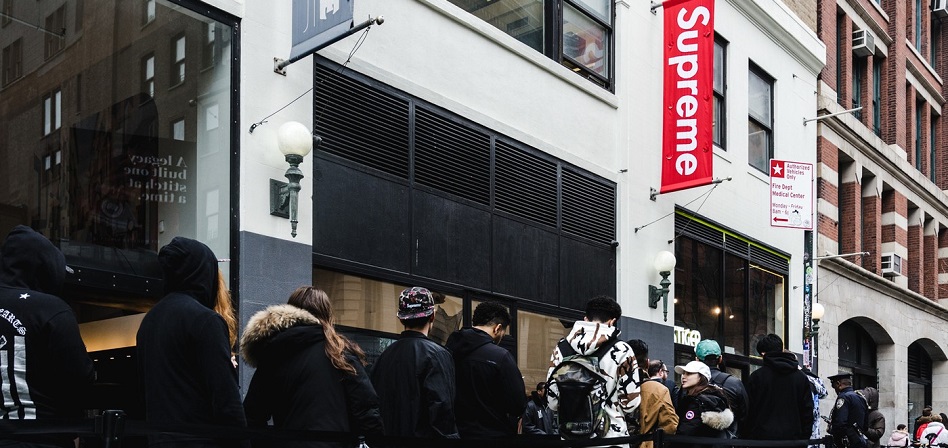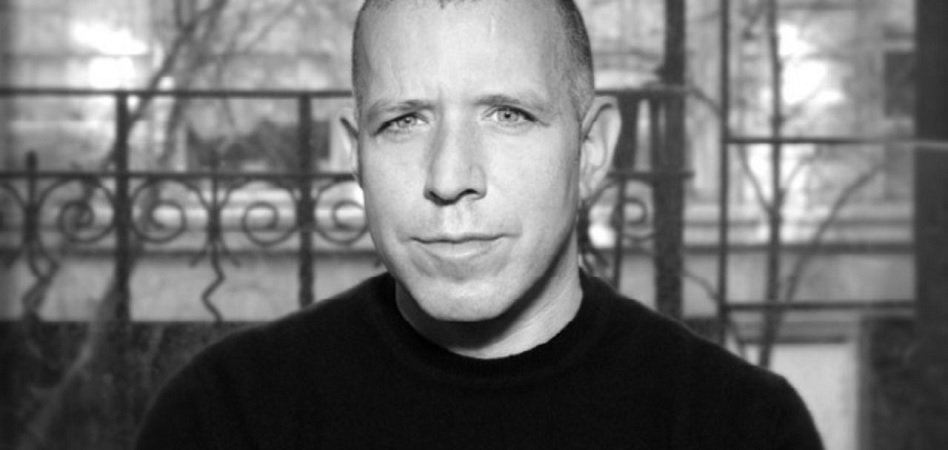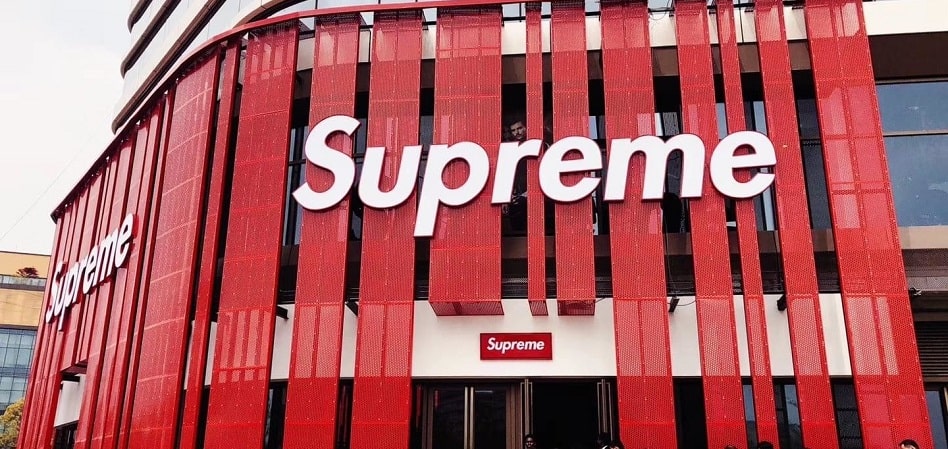Supreme vs. Supreme: the story of the streetwear king’s (legal?) fake
International Brand Firm has been using the same logo as the New York-based company for five years. But while the American begins to win the battle in court, the Italian (with a flagship in Shanghai with skateboard ramp included) continues to advance in the streets and increasing its revenue.

In the center of Barcelona, just a few steps away from touristic street Las Ramblas, two young boys take a selfie in front of a store window. The sign on the door and the garments inside are almost indistinguishable from those of Supreme, the king of streetwear born in New York in 1994. But Supreme doesn’t have any stores in Spain.
International Brand Firm (IBF), owned by an Italian businessman, has been operating the same logo for five years than the New York-based company, valued by Carlyle in one billion dollars. But while the American begins to win the battle in court, the Italian continues to expand in the streets.
Not only the young people in Barcelona confuse them. In 2018, Samsung announced a collaboration with Supreme in China on the occasion of the launch of the Galaxy A8s. Only four months later, the Korean giant published a statement announcing that it broke the alliance: it was the false Supreme, controlled by the same Italian businessman. This same month, the Australian brand YPL signed a collection with the same company.
The Italian company is not a so-called legal fake, since it was not trademarked before the New York-based
How did it get here?
Counterfeits are common in the fashion business. In 2017 alone, the market for clothing, textiles, footwear, handbags, cosmetics and counterfeit watches amounted to 450,000 million dollars, according to data collected by The Fashion Law.
According to another report by Ghost Data, sales of luxury counterfeits through the Internet amount to 30.3 billion dollars. Online, it is easy to find confusing domains to buy fake Christian Louboutin, Chanel or Gucci. But it’s much less usual to find a flagship store of these distributors of replicas in the city center. How has an Italian businessman managed to build a network of five stores in Spain and open another flagship in Shanghai, with skate ramp included?
Part of the answer is found in Supreme’s own origins. The company started in 1994 with a store in lower Manhattan. His logo, with white letters with the Futura Heavy Oblique typography on a red rectangle, uses the same combination that the conceptual artist Barbara Kruger has used in her works since the 1980s. Supreme’s parent company, Chapter 4, did not register the trademark in the United States until 2012.
Supreme first appointed a general counsel in 2017, when Carlyle bought a stake in the company
That is the same year that his Italian doppelgänger began its path, led by businessman Michele Di Pierro, according to the Italian press. However, it did not begin to be known until 2016. In Italy, it was nicknamed Supreme Barletta after its founder’s home town, and it was distributed in a thousand points of sales throughout the country.
The group operates at least through two companies: International Brand Firm Ltd, based in the United Kingdom; and International Brands SRL, domiciled in Italy. The first revenue reached 513,994 pounds in 2017, according to the latest accounts available; the second had sales of 258,158 euros in the same year. Both had profits that year.
This company has often been described as a legal fake, considering that it had begun operating in Italy before the original had registered the trademark in the country. But the truth is that there is no record of Supreme Barletta trademark until November 2015, one month after Chapter 4 did, according to CNN.

The legal war took two more years to arrive. In 2017, The Carlyle Group acquired 50% of Supreme for 500 million dollars, valuing the company at one billion dollars.
It was then that the company appointed its first general counsel, Darci J. Bailey, who undertook the global trademark registration strategy, with over 350 trademark filings around the globe, and the fight against counterfeiting
The company then took legal action in the courts of Milan, which ruled in favor of the American group. The accusation also argued that the Italian company had taken advantage of the international notoriety of the New York-based brand that, although it had not made specific marketing campaings in Italy and had no stores there, was known in the country. For the past two years they've been shutdown in Italy, unable to operate as the local courts ruled that they are counterfeiters and practicing "parasitic" behavior.
After the ruling, which is not yet definitive, the Italian company sought for more business in Spain, where it had been working with a local distributor for a few months. It was in the Iberian market where Supreme Barletta, became Supreme Spain, decided to start building a retail network and opened five stores in Madrid, Ibiza, Barcelona, Palma and Formentera.

The trademark registration in Spain was made in April 2017, five days after Supreme did it, according to CNN. The New York-based brand has also filed with the European Union Intellectual Property Office. A source familiar of the brand has explained to Mds that although IBF had trademarked a very similar logo in Spain, but on a yellow background, it uses the red version in products and stores.
The Italian group also operates two other stores in China, where it works with a local partner. The last straw came in 2019, when IBF opened the first store in Shanghai. Supreme then published the first public statement referring to this matter and James Jebbia granted the first interview to talk about counterfeits, although not directly mentioning the Italian company.
The case is not unique. Susan Scafidi, founder of the Fashion Law Institute, reminded Mds that other firms such as Boy London or Kith have gone through similar processes.
“Registering a brand worldwide means a lot of time and effort, but not doing so exposes you to these conflicts,” says the expert. According to Scafidi, “Supreme’s case is a new example of an old problem,” which has now been magnified because “in streetwear, the nature of the product is simple and easy to imitate.” In the case of Supreme, much of the brand value resides in its logo, which has been marketed in all types of products, from strips to Louis Vuitton bags.

From Nike to Puma: the other fashion ‘Doppelgänger’
In Spain, one of the greatest wars for the trademark of a fashion brand is named after a Greek goddess. For two years, two Nike coexisted in the country: that of the popular American sports fashion company and that of its distributor in Spain.
Nike began its expansion in Spain in 1979 together with local distributor Comercial Ibérica de Exclusivas Deportivas. When it tried to register its trademark in in the country, the group discovered that in Spain there was already a goddess of victory long, long before: a textile family from Sabadell had registered the name since 1932 for its use in textile articles.
Comercial Ibérica bought the brand, and it was agreed that while the footwear will be imported from the parent company in the United States, the textile would be manufactured in Spain. The agreement was beneficial for both parties for years until, in 1986, the same year that Barcelona won the battle for the Olympic Games, Nike decided to continue on its own and created a subsidiary in Spain, American Nike.
In 1990, the American managed to register the brand in the country, opening an unusual situation: for years two Nike coexisted in Spain: that of the swoosh, from Oregon, and that of the goddess Niké, from Barcelona.
The legal war that came later became a battle between two of the largest law firms in Spain: Gómez-Acebo y Pombo, which defended the Americans; and Garrigues Walker, in defense of the Spanish. In 1999, the Supreme Court gave the reason to the American company and, after several appeals, in 2004 the Supreme Court ended up again ruling in favor of Phil Knight’s Nike.
Another sportswear company, Puma, maintained several years of judicial litigation against its distributor in the country, Estudio 2000, for seizing the rights to use its brand in the Spanish market. While it did not gain control of them, Puma used for several years the name Dassler Puma in the Spanish market. Meanwhile, the Spanish did even stamp its logo on the jerseys of the Cameroon National Football Team in 2004.


info@themds.com
Validation policy for comments:
MDS does not perform prior verification for the publication of comments. However, to prevent anonymous comments from affecting the rights of third parties without the ability to reply, all comments require a valid email address, which won’t be visible or shared.
Enter your name and email address to be able to comment on this news: once you click on the link you will find within your verification email, your comment will be published.